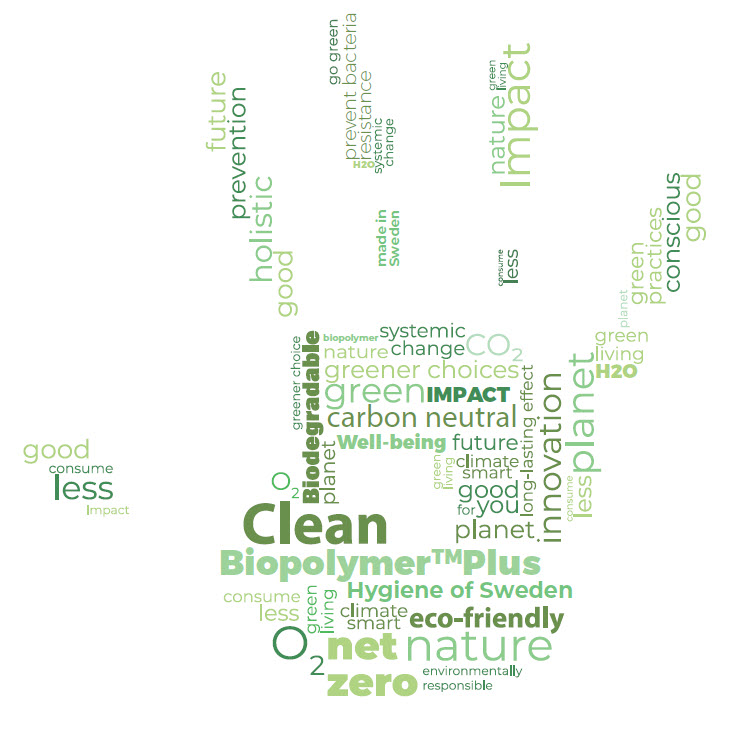Environmental Product Declaration

Our Philosophy
Our lab is dedicated to find and innovate new solutions to eliminate and minimize existing hazardous chemicals used in our daily life.
With a holistic perspective we question all the steps in the supply chain, from raw materials to the final product.
Introduction
Biopolymer™plus, our alcohol free antibacterial formula is disrupting the Hygiene Industry.
Designed to be fully effective and functional we are extremely proud to be able to present a solution with several advantages compared to traditional hand sanitizers and at the same time being a more sustainable solution.
Our goal with this Green Bioscience document is to highlight the environmental impact you make when selecting the Biopolymer™plus formula as your preferred protector against germs.
Certificates
Our production facilities are accredited with the following certificates.
ISO 9000 is today the most widely used common standard in terms of quality. ISO 9001 deals with development, production, installation and service. ISO 9001 is the most comprehensive standard in the ISO 9000 series
ISO 14001 is an international standard for environmental management. The standard is the most dominant environmental management standard in the world.
ETHANOL PRODUCTION
DEFORESTATION
The ethanol industry is expanding in Brazil, with growing concerns of deforestation of the Amazon rainforest in favor of sugar cane crops.
Deforestation, air pollution,
disturbing the ecosystem
FERTILIZING AND THE USE OF PESTICIDES
There are growing concerns how sugar cane plantations around the world treat affect water sources and the soil.
CROP BURNING
It is common, but controversial practice to burn sugar cane fields before harvest to reduce mass and use the ashes as nutrients.
Air pollution
MECHANICAL HARVESTING
Fossil fuel powered machines harvest the crop and transport it to fermentation.
FERMENTATION
1000 l of water is added to every 150 kg sugar. Yeast is added and the mash is allowed to ferment to a 15% alcohol mixture. CO2 is a byproduct that is often captured for use in other areas.
DISTILLATION
Only about 15% of the fermented mash is converted to ethanol. The rest is considered waste and is discarded.
WASTE
140 kg dried residue
86 kg cellulose
800 liters of stillage
YIELD
80 liters of 95,5% proof ethanol
WASTE TO ETHANOL RATIO
10 : 1
ETHANOL TRANSPORT
SHIPPING
Shipping accounts for over 10% of transport CO2 emissions and is a major source of air pollution
MANUFACTURING OF SPECIAL EQUIPMENT
LAND TRANSPORTS
RISK OF ACCIDENTS
YIELD
END PRODUCT
100 liters of 80% proof ethanol
ETHANOL OFFERS ONLY 20% SAVINGS IN SHIPPING VOLUME
ETHANOL CONSUMPTION
MANUFACTURING SPECIAL STORAGE
ADDITIONAL SECURITY MEASURES
A plentitude of resources, in equipment and manpower, are required to keep alcohol in safe hands.
Energy consumption, waste, risk
REPLACEMENT OF DAMAGED MATERIALS
IGNORING SAFETY PROTOCOLS
RECYCLING CHALLENGES
Both the discarded ethanol and the plastic container should be discarded in special recycling facilities for solvents. Empty hand sanitizer bottles are rarely, if ever, recycled properly.
LONG TERM CONCERNS
As ethanol evaporates and reacts with the environment it offer no long term protection. The only solution is to use more alcohol which causes more even bigger burden on the environment.
Creating Multi resistant BACTERIA
Using only a single active ingredient may cause the bacteria to become resistant causing strains that require even higher concentrations of active ingredients to kill
The Environmental Impact of Health Services
'A 10% reduction in emissions from just the US health system would have the same atmospheric impact as a 10% reduction in emissions from the entire Australian economy.'
Benefits
Of Biopolymer™plusThe key to green bioscience in regards to hand sanitizing and desinfection is to use a concentrate. It is essential to have a solution that can be mixed to the correct concentration locally. Our ratio of active ingredient is less than 0,05% which allows us to manufacture and ship only 1 liter of non-classified concentrate that can make up to 2000 liters of ‘ready to be used’ disinfectant, with long-term protection.



